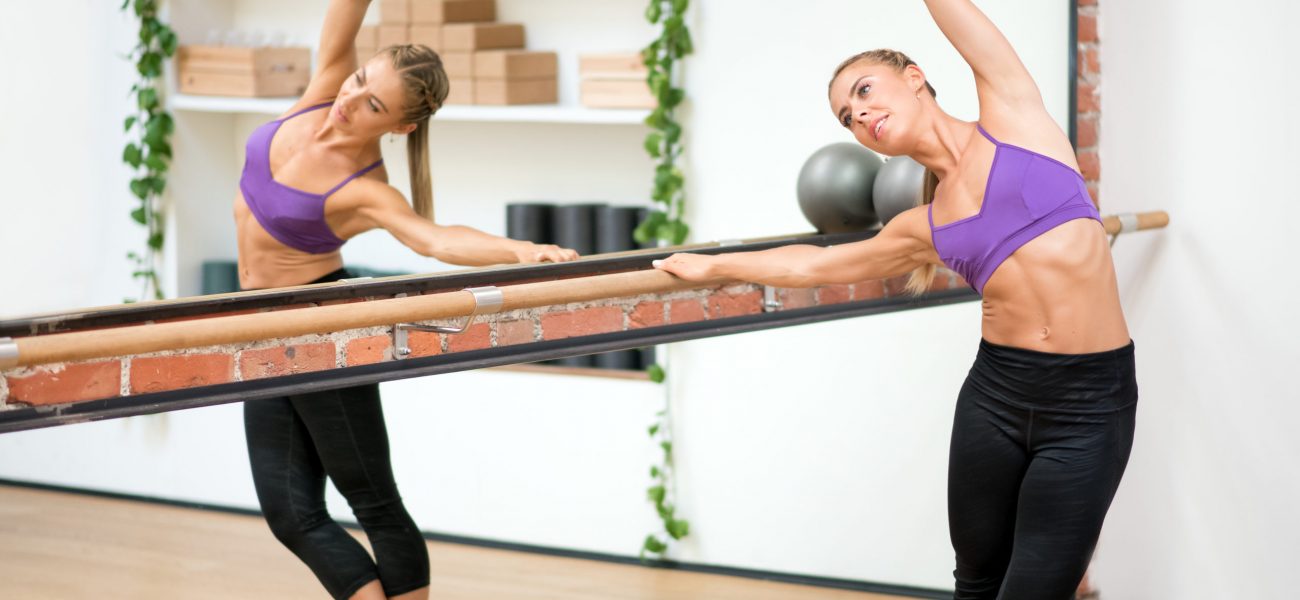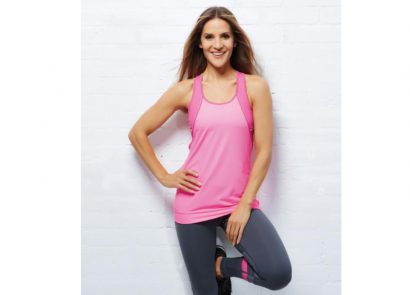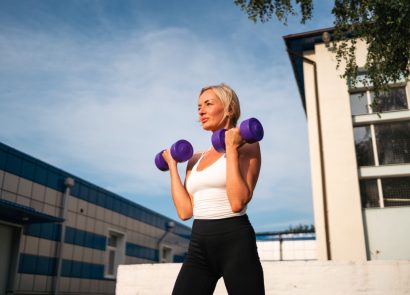Like most little girls, I dreamt of becoming a ballerina. I was four years old when I got my first jewellery box and I was so taken with the tiny, twirling dancer swathed in a pink tutu and satin shoes that I ripped her from the box at once so I could take her with me everywhere. Fast forward 22 years and that childhood infatuation developed into more of a romantic fantasy when I watched my first live performance of The Nutcracker. Looking down from the balcony, I imagined myself among the army of dancers on stage – poised and athletic with an ethereal elegance. But little did I know that it wasn’t magic stardust that propelled the sugar plum fairies into the arms of the prince, it was strong core muscles, powerful quads and robust glutes and back muscles. Since the Oscar-winning film Black Swan was released in 2010, our fascination with ballet has reached fever pitch. Although many of us don’t have the time, discipline or (ahem) grace to pursue a new career as a full-time ballerina, we wouldn’t say no to achieving the body and fitness level of one. And thanks to Natalie Portman’s spectacular transformation, ballet inspired workout classes have been popping up all over the UK ever since to make that possible in a barre studio – without the scary fasting and blistered toes. Win-win! Here, we take a look at the benefits of barre workouts on your body.
Why is it called barre?
The barre method was created by the dancer Lottie Berk in 1959. It combines a ballet workout with Pilates and yoga moves using a ballet barre, from which it derives its name, and is beloved by many celebs, including Calgary Avansino and Lisa Snowdon. You may be wondering ‘what’s the difference between a Pilates class and a barre class?’ – and although barre fitness does take inspiration from Pilates, to do a barre workout, you simply need your own body weight, a ballet barre and occasionally a yoga mat for floor work, whereas Pilates uses everything from reformer equipment to light hand weights. A ballet barre fitness workout does take ideas from yoga too, but unlike yoga, barre also incorporates aerobic exercises for additional cardiovascular and weight loss benefits.
What can you use instead of a barre?
If you’re not ready to head to a barre class at a barre studio, and instead want to do a home workout using one of the many barre exercise videos available online run by a fitness expert, you’ll be pleased to know that you don’t need your very own barre to do this workout. In fact, you can use anything at your disposal, as long as it’s sturdy and you have enough room to complete a barre routine and discover the benefits of barre workouts – from your kitchen island to the back of a chair.
What kind of workout is barre?
If you thought that ballet wasn’t as demanding on the body as cardio exercise such as running or strength training, you’ll soon change your mind after a barre class. As one of the first to offer dance-focused fitness classes, Barrecore founder Niki Rein wanted to create a space that would hone a woman’s physique, increase core muscle strength and create a lean silhouette. “Think high repetition isometric exercise and compound movements until you reach muscle fatigue and they start to quiver and shake – that’s a barre class,” says Lisa Todd, a Barrecore instructor. “We then lengthen out the muscles with a deep stretch to target each specific muscle. It’s high intensity cardio, but low impact exercise, meaning you get a great resistance and cardiovascular workout that will blast fat, kickstart weight loss, improve your endurance, boost your heart rate, heighten core strength and increase your metabolism throughout the day.”
Torching calories long after your workout is a benefit of high intensity interval exercise, but Vicki Anstey, founder of ballet fitness fusion studio Barreworks, stresses that the benefits of barre workouts are something very different. “Many sports and high impact exercise focus on dynamic, powerful movements, neglecting the all-important postural muscles that keep our bodies held together, functioning in a well-balanced state,” she says. “By setting the foundations of strong bio-mechanics, ballet lifts bottoms, creates chiselled abs, trims thighs and defines arms, giving you perfect posture and a sculpted physique.”
Thanks to the combination of small, controlled isometric movement types that work multiple muscle groups, there’s no danger of your body bulking up – a ballet dancer’s biggest fear. “The beauty of doing exercise in turn-out (pointing your toes outwards) is that it will lengthen muscle and improve lean muscle definition, rather than bulking them,” says barre instructor Aaron Dwyer. “Ballet is one of the few types of fitness that requires physical and muscular endurance, stability, physical strength, stamina and flexibility, making it a full body workout.”
Do you need any ballet experience to do a barre workout?
A sculpted figure, strong body and the posture of a swan without heavy weights or resistance bands in sight? Surely we have to have some past experience under our belts and know the classic ballet and barre moves. “Absolutely not,” Lisa says. “A barre class is suitable for all age groups and fitness levels – from the injured to the pregnant. It can even help strengthen muscles that have become weak from a trauma or some time off.”
Although trained gym instructors are adequate enough to take barre classes, Vicki admits that a qualified dancer has added benefits. “While you’re certainly not expected to be a prima ballerina, our teachers include Royal Ballet School and English National Ballet trained dancers, so you know you’re learning from the very best,” she says. “They know how to work the body in a particular way and know how you’re feeling from first-hand experience. While you may not be flexible during your first class, stick with it and you’ll soon be amazed by what your body can do!” Still wondering if it’s for you? “I have an 82 year old lady who attends my class so you can never say you’re too old to dance!” Aaron tells us.
How long does it take to see results from a barre workout class?
As much as we’d like to put in the full-time hours of a professional ballerina, there’s no need to give up your day job just yet. “You don’t need to train as hard as a pro to see the results – you’ll be able to see a big difference after just a few sessions,” Lisa says. “After four classes a week, you will see a flatter stomach, defined muscle and a perkier derrière! The key to getting through a dance class is to give everything a try and know that each time it will challenge you in a different way.”
However Vicki is confident that you’ll see a difference and feel the benefits of barre workouts a lot sooner. “After just one class, you’ll see an improved posture – you can instantly add inches from your waist to your height, just by adopting the correct posture,” she says. “Once you have got to grips with some of the terminology you’ll be able to start putting combinations together quickly.” Other benefits of ballet barre training also include increased cardiovascular endurance and weight loss – you can burn up to 450 calories per barre workout! Plus, you help to strengthen your pelvic floor muscle group.
So now that we’re bona fide ballerinas, what else do we need to know to do a barre workout? “Let yourself go and don’t worry about anyone else in the barre studio – each of our bodies are different, some things you will be able to do that others won’t and vice versa,” Aaron says. But before you invest in a tutu (we know you’re dying to!), Vicki suggests something a little more modest to begin with. “Exercise clothing and bare feet is fine for ballet barre first-timers. But once you’re hooked, it helps to have a pair of soft-soled ballet shoes or barre grip socks so that your feet are protected. Then, the world is your oyster! Invest in super-soft fitness leggings and layer up in true ballet-style with leg warmers, crossover cardigans and a back-enhancing leotard, if you dare,” she says.
Does barre tone your arms?
While it may seem like a barre class focuses on your lower body, glute muscles and core strength, you can also count defined arms as one of the many benefits of barre workouts. This is because barre incorporates body weight exercises and strength training to create a full-body workout that targets every muscle.






















